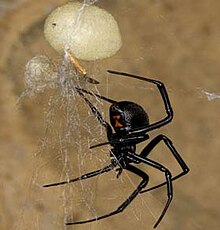Spiders' egg case silk gene found
Wednesday, August 3, 2005

Two researchers at the University of California, Riverside have found a gene coding for a silk protein used by female spiders to construct their egg cases. The research confirms that the silk protein used for the egg case is different than that used in spider webs. Spider silks are renowned for their superior material properties, being among the toughest known natural fibers. The researchers' findings may lead to new applications of spider silks for novel high-tech materials. The researchers, Jessica Garb and Cheryl Hayashi, published their findings in the Proceedings of the National Academy of Sciences on August 1, in the early edition of the journal.
Until now, the sequence of the silk protein used to construct the egg case was unknown. The team characterized the egg case silk protein from multiple spider species and found within a species its gene was composed of nearly identical, repeating sequences. The repeat units were also similar across species that diverged more than 125 million years ago. Their findings suggest that the egg case silk gene has been undergoing what is known as concerted evolution where mutations in one part of the gene "spread" to other parts of the same gene, creating a highly repetitive gene sequence.
"The protein of the egg-case fibers has a different function altogether from that of the other silks such as dragline or capture silks," Garb said. "Egg-case silk has to last a long time and therefore must be durable under a wide variety of conditions, from freezing to very high temperatures. It needs to be strong enough to protect the eggs from threats such as predators, parasites and molds."
Although the egg case silk protein is extremely different, its gene sequence shares certain features in common with all other spider silk genes. According to Garb, this discovery confirms that spider silk genes comprise what is known as a "gene family". This means that silk genes first evolved with spiders approximately 400 million years ago and subsequently evolved into different genes specifically used for different functions, such as genes for spider webs or genes for egg cases (Gatesy et al. 2001). The researchers also suggest that there are many more silk genes that remain unknown, particularly as there are more than 37,000 known species of spiders, and silk genes sequences have been described from only a few species.
According to the team, this unknown diversity of silk genes may not only be important for understanding spider evolution but also for the development of genetically modified fibers. "Collectively, spider silks are some of the toughest natural fibers known," Hayashi said. "Imagine a fabric made from such a substance? It would be incredibly strong, flexible and ultimately, biodegradable."
Sources
[edit]- Jessica Garb and Cheryl Hayashi. "Modular Evolution of Egg Case Silk Genes Across Orb-Weaving Spider Superfamilies" — Proceedings of the National Academy of Sciences, August 1, 2005
- "Silk genes shed light on spider evolution" — Proceedings of the National Academy of Sciences, August 5, 2005 (in early edition highlights)
- Stefan Lovgren. "Gene for Key Spider-Silk Protein Found" — National Geographic, August 2, 2005 (in online edition)
- Ricardo Duran. "Biologists Crack Genetic Code for Specialized Spider Silk" — UCR News, August 1, 2005
- John Gatesy et al.. "Extreme Diversity, Conservation and Convergence of Spider Silk Fibrion Sequences" — Science (journal), 2001

